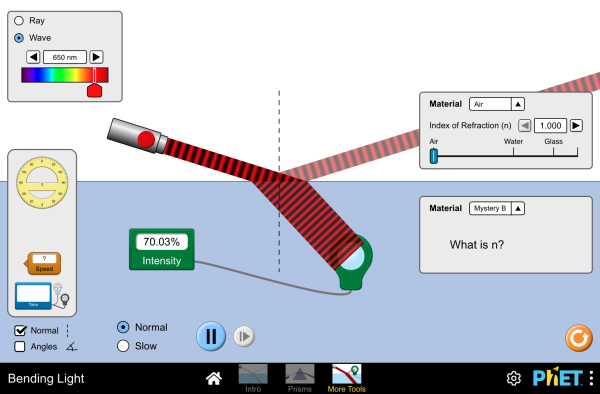Digital information visuals can be impressive tools for teaching. It has long been recognized that visuals play an important role in learning. Strenburg looks back to Aristotle and Plato explanation that imagery plays a crucial role in all thought processes, and provides the semantic grounding for language (as cited in Edens and Potter, 2008, p. 185). The digital information visuals that are available to today offer impressive opportunities to help students grasp challenging and often abstract conceptual concepts.
High-quality interactive simulations in a program like PhET allows students unique opportunities to interact with visual simulations. They can be used to set the stage for problem-solving or can be used to experiment and discover cause and effect relationships. For example, students in grade 4 can visualize light as waves or rays and discover through simulated activities related to refraction by directing light through mediums of varying density and at varying speed. Exploring is simulations in this way can provide students with optimal learning challenges and a point of convent engagement. Edens and Potter 2008, shed light on the benefits visuals in their research of schematic visuals as an aid for problem-solving among fourth and fifth-grade students. They discovered that using schematic visuals helped to lay the foundation for the steps needed to effectively problem solve.
Another benefit of digital information visuals is their cost-effectiveness. For teachers and administrators, simulations are a cost effective means of providing students with experiences that are less expensive than real-life experiences (Srinivasan et al., 2006). These tools offer low-cost, easy access to high-quality interactions. Combined with their interactive abilities they offer with fewer limitations than pencil and paper. However, educators should remain cautious in their approach to using simulations as a means of providing authentic and unique learning experiences for students. In a study conducted by Srinivasan et al., (2006), over half of the students interviewed valued “real” experiences over simulations. Comments such as theses should trigger teachers not to overestimate the benefits of authentic experiences for students by turning to the ease and convenience of digital visuals tools.
My view of digital visualization tools are that they have many beneficial affordances for both teachers and students. They are versatile in the fact that they can be used to: reinforce or promote learning; compliment what is being taught; help illustrate difficult topics. These tools should be included as one of the many tools teachers and students access to promote learning. Teachers in their efforts to provide deep and rich learning experiences should view these supports agains the backdrop of other strategies (e.g., real world expeiences) and aim to strike a balance that leads to the most optimal and reasonable experience for students.
References
Edens, K. and Potter, E. (2008), How Students “Unpack” the Structure of a Word Problem: Graphic Representations and Problem Solving. School Science and Mathematics, 108: 184–196. doi:10.1111/j.1949-8594.2008.tb17827.x
The University of Colorado Boulder. (2017). PhET Interactive Simulations. Retrieved from https://phet.colorado.edu/en/simulations/category/new
Srinivasan, S., Pérez, L., Palmer, R., Brooks, D., Wilson, K., & Fowler, D. (2006). Reality versus Simulation. Journal of Science Education and Technology, 15(2), 137-141. Retrieved from http://www.jstor.org.ezproxy.library.ubc.ca/stable/40186678
